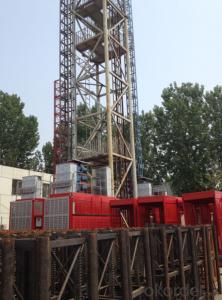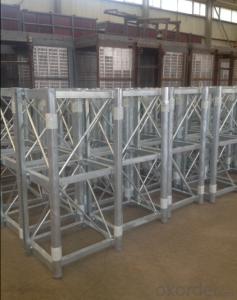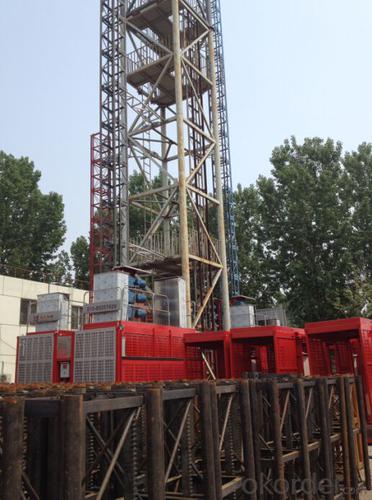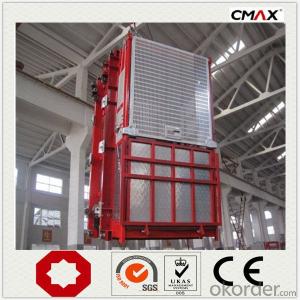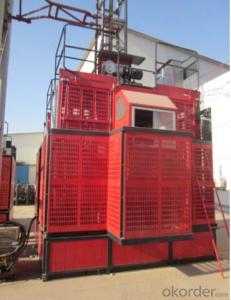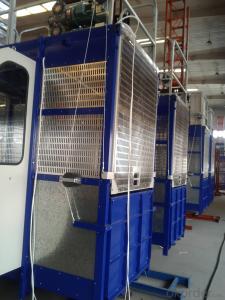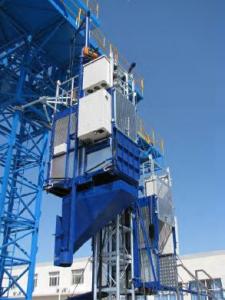Construction Building Material Hoist Winch Hoist with Capacity 200 to 1000kg
- Loading Port:
- Tianjin
- Payment Terms:
- TT OR LC
- Min Order Qty:
- 1 set
- Supply Capability:
- 1000 set/month
OKorder Service Pledge
OKorder Financial Service
You Might Also Like
Specification
SC200/200 3*2*11kw building electric hoist
Descriptions of our building hoist:
SC100 construction hoist is a new generation product designed by construction mechanization research, Chinese Academy of Architecture. It is of high technology and of high safety, convenient to maintain, is an ideal Vertical transport tool for modern building .
Main Features of Building Material Hoist
1. the recommended cage dimension(LXWXH):2.0X1.0X2.5, 2.5X1.0X2.5, 2.5X1.3X2.5, 3.0X1.5X2.5, 3.2X1.5X2.5, 3.8X1.5X2.5, 4.0X1.5X2.5, 4.2X1.5X2.5 etc, we can also manufacture cages of other size according to the user.
2. The cage and the door material can be aluminum molded board, punched-plate, figured aluminum board or other type according to your requirements.
3. The mast and the tie-in surface can adopt paint-spray, or hot galvanizeing processing.
Advantage of our building hoist:
1. Our own systems of production engineering.
2. Production design from the concept to the engineering details.
3. Technical experts with great experience in the sector.
4. Continuous development of new solutions and products adapted to the requirements of our clients.
5. Methodology and project procedure administration in compliance with current guidelines.
6. Extensive worldwide commercial network
Specification of our building hoist:
Characteristic | Model | Rated Loading | Lifting Speed | Motor Power |
Double cabin | SC200/200 | 2×2000kg | 33m/min | 2×(3×11kw) |
SC150/150 | 2×1500kg | 33m/min | 2×(2×15kw) | |
SC100/100 | 2×1000kg | 33m/min | 2×(2×11kw) | |
Single cabin | SC200 | 2000kg | 33m/min | 3×11kw |
SC150 | 1500kg | 33m/min | 2×15kw | |
SC100 | 1000kg | 33m/min | 2×11kw |
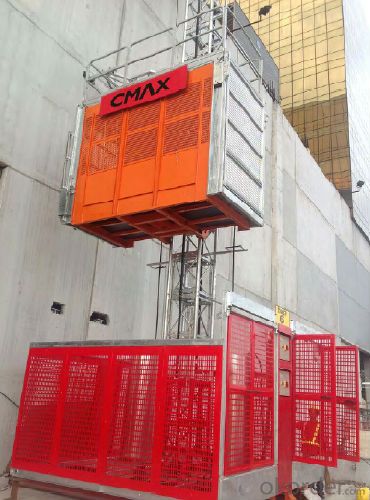
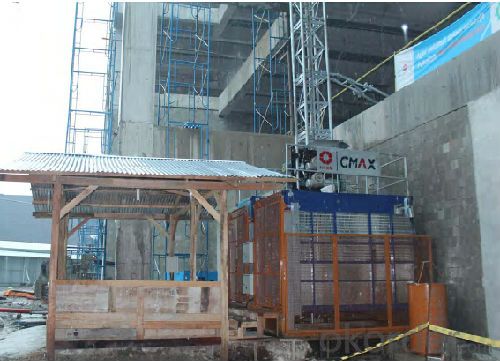


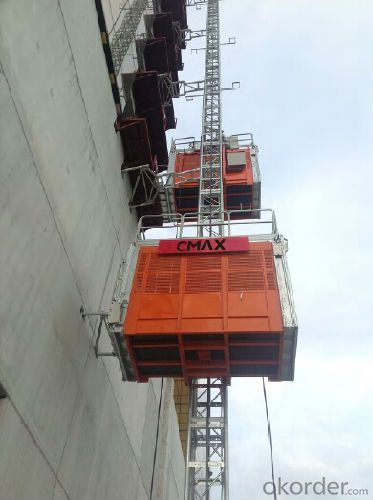
Production line
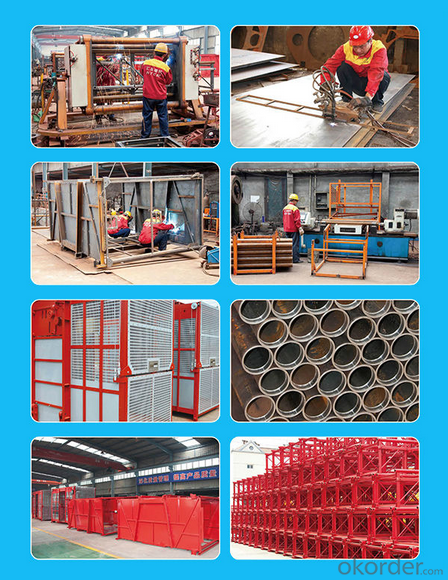
FAQ
1. why chose us?
China National Building Materials (Group) Corporation (CNBM), established in 1984,now is one of the largest state-owned group corporation in China, dealing with building materials & industrial equipment. Up to year 2010, CNBM Group's total asset is 20 billion USD and total staff is more than 100,000.CNBM International Corporation, specializes in designing & manufacturing of various
kinds of construction machinery, including tower crane, building hoist, etc. All the equipment produced by CNBM are compliant with the National level quality standard, and wins great reputation for their endurable performance in worldwide markets.
2.How about the shipment?
You can put 2 sets of of wheel loaders in one 40HQ container. The spare parts are packed with boxes.
The delivery time is 20 days.
3. What about your service?
We have our factory, we can meet customers needs as soon as possible.
We have first rate professional technology and provide good after-sales service.
4.After Sales Service
We offer the Preventative Maintenance and After Sales Service. For we strongly feels about the importance of supporting our customers and the product solutions we provide. Consequently we offer comprehensive maintenance options to prevent equipment issues before they become problems. Also we offer one year guarantee period.
- Q: Is it permissible to use a building hoist for lifting people?
- <p>Building hoists are not designed for lifting people and doing so can be extremely dangerous. They are specifically engineered for the transportation of materials and equipment in construction settings. Using a building hoist to lift people violates safety regulations and can result in severe accidents. Always adhere to the manufacturer's guidelines and local safety laws, which prohibit the use of building hoists for carrying personnel.</p>
- Q: Can a building hoist be utilized for the transportation of objects within and between buildings?
- <p>Yes, building hoists are specifically designed to move objects vertically within buildings. They are commonly used in construction to lift materials and equipment to different floors. Additionally, they can be employed to transport objects into and out of buildings, especially when access is limited or when heavy loads need to be moved over short vertical distances. However, it's important to adhere to safety guidelines and regulations when operating a building hoist to ensure the secure and efficient movement of objects.</p>
- Q: This question asks for an explanation of how to use an overload protection device specifically in the context of a building hoist.
- <p>An overload protection device is crucial for a building hoist to prevent accidents caused by excessive weight. First, ensure the device is correctly installed and calibrated according to the manufacturer's instructions. Before operating the hoist, set the overload limit based on the hoist's capacity. During operation, if the load exceeds the set limit, the device should automatically shut down the hoist, preventing further operation. Regularly inspect and test the device to ensure it functions properly. Always follow safety protocols and never attempt to bypass or disable the overload protection system.</p>
- Q: Can a building hoist be utilized to lift more than one object simultaneously?
- <p>Yes, a building hoist can be used to lift multiple objects at once, provided that the combined weight of the objects does not exceed the hoist's maximum load capacity. This is often done by securing all objects to a single lifting point or using a pallet or platform to hold the objects together. It's crucial to ensure that the hoist is rated for the total weight and that the objects are evenly distributed to maintain balance during lifting. Always follow safety guidelines and manufacturer's instructions to prevent accidents.</p>
- Q: A lift motor is 7.5 KW, and the frequency converter sends current 4.2 A, which has A heating resistance in the converter, and how the charge is calculated when the lift is full. Or consider the power of the converter and the power of the thermal resistance.
- Use electricity in the field (1) lifting equipment class: tower crane 2, construction elevator 3; According to the table, K = 0.3 cos phi = 0.7 tg phi = 1.02 JC = 40% (temporary load) Pe = 2 times 63 + 3 times 11 = 159 (kW) And then power: PS = 2 times Pe = 2 times 159 = 201 (kW) Pjs1 = K * PS = 0.3 * 201 = 60.3 (kW) Qjs1 = tg phi by Pjs1 = 1.02 times 60.3 = 61.5 (kVA)
- Q: This question asks for an identification of the various types of lifting equipment that are specifically utilized in the context of building hoists.
- <p>Different types of lifting equipment used for building hoists include: 1. Electric Chain Hoists, which are versatile and suitable for various lifting tasks. 2. Manual Chain Hoists, that require manual operation and are used for lighter loads. 3. Electric Wire Rope Hoists, known for their high lifting capacity and durability. 4. Air Hoists, which are powered by compressed air and are ideal for environments where electricity is hazardous. 5. Geared Winches, used for pulling or lifting heavy loads with precision. 6. Jib Cranes, which provide a fixed or semi-fixed lifting solution in workshops. 7. Gantry Cranes, used for lifting heavy loads over a specific area. Each type serves specific purposes and is chosen based on the weight, environment, and specific requirements of the construction project.</p>
- Q: This question asks for methods to protect lifting equipment from damage while it is being transported or stored.
- <p>To prevent damage to lifting equipment during transportation or storage, follow these guidelines: 1. Use protective covers or wraps to shield equipment from environmental elements. 2. Securely fasten equipment to prevent movement during transit. 3. Store equipment in a dry, clean area to avoid rust and dirt accumulation. 4. Regularly inspect equipment for signs of wear or damage before and after use. 5. Follow the manufacturer's guidelines for weight limits and proper handling. 6. Use padding or cushioning materials to protect equipment from impacts. 7. Ensure that all parts are properly lubricated to prevent rust and facilitate smooth operation. By adhering to these practices, you can significantly reduce the risk of damage to lifting equipment.</p>
- Q: Is it possible to use a building hoist to lift various materials simultaneously?
- <p>Yes, a building hoist can be used for lifting multiple materials at once, provided the total weight does not exceed the hoist's load capacity. It's crucial to ensure that the materials are securely fastened and balanced to prevent tipping or damage. Always follow the manufacturer's guidelines and safety regulations to avoid accidents and ensure the safe operation of the hoist.</p>
- Q: This question asks for the process of changing the height at which a building hoist operates.
- <p>Adjusting the height of a building hoist typically involves a few key steps. First, ensure the hoist is powered off and disconnected from any power source to ensure safety. Next, locate the hoist's height adjustment mechanism, which may be a set of bolts or a telescoping column. Loosen any locking nuts or bolts that secure the current height setting. Adjust the hoist to the desired height by raising or lowering the platform or mast. Once the desired height is reached, tighten the locking nuts or bolts to secure the hoist in place. It's crucial to check the manufacturer's guidelines for your specific hoist model, as the process may vary. Always follow safety protocols and consult with a professional if you're unsure about any steps.</p>
- Q: What are the necessary maintenance tasks and considerations for ensuring the safe and efficient operation of a building hoist?
- <p>The maintenance requirements for a building hoist include regular inspections, lubrication, and checks on all mechanical components. It is crucial to inspect the hoist's cables, pulleys, and brackets for wear and tear. The drive mechanism and safety devices should be tested for proper functioning. Lubrication of moving parts is essential to reduce friction and prevent overheating. Additionally, the electrical system should be checked for any faults or damage. It's important to keep the hoist clean and free of debris to prevent any operational issues. Following the manufacturer's guidelines for maintenance intervals and procedures is vital to ensure the hoist remains safe and efficient.</p>
Send your message to us
Construction Building Material Hoist Winch Hoist with Capacity 200 to 1000kg
- Loading Port:
- Tianjin
- Payment Terms:
- TT OR LC
- Min Order Qty:
- 1 set
- Supply Capability:
- 1000 set/month
OKorder Service Pledge
OKorder Financial Service
Similar products
Hot products
Hot Searches
Related keywords
